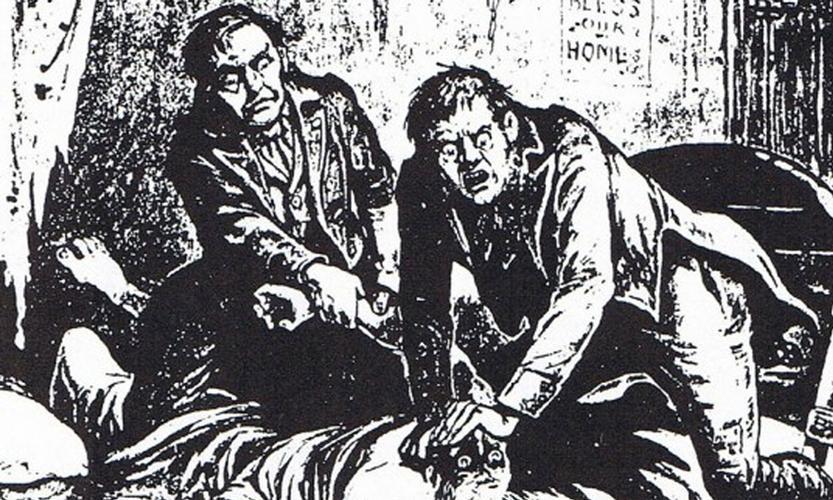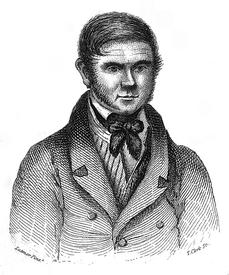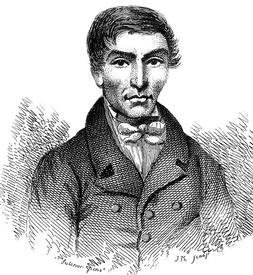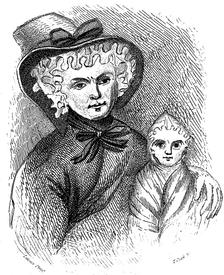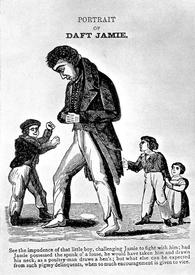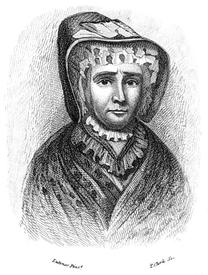On the evening of Halloween 1828, a Friday, three guests were drinking at a boarding house in
Edinburgh with their hosts. Two of them, James and Ann Gray, were invited to stay at an adjoining
boarding house and arose the following morning. The third, Marjory Campbell Docherty, was not to
see the light of day again.
She was to be the final victim of William Burke and William Hare, who had been murdering lodgers in their boarding house and selling the corpses to a scientist, Robert Knox, who was well known for his anatomical classes in the city’s surgeon square. In an age where curiosity about the human body meant that ‘gravedigging’ fresh corpses from their resting places was a common and lucrative trade, the two men had decided to produce their own corpses for considerable profits.
With the help of their respective wives, Helen and Margaret, Burke and Hare had been on their murderous spree for nearly a year and were only brought to a halt because of a careless mistake.
The case shocked the city and the rest of Britain, and shed light on this murky industry involving the
sale and purchase of fresh corpses. Although it was illegal to engage in this trade, authorities often
turned a blind eye to the scientists whose supply of fresh corpses far outweighed the supply of
executed criminals who they were legally allowed to use for their experiments. Given the medical
benefits that this study in human anatomy could bring, the majority of the people involved in the
industry were not likely to be punished unless they were caught in the physical act of digging a grave
up or transporting a fresh corpse to their client.
In essence, Burke and Hare had taken the logical, if terribly immoral, next step and made corpses for
themselves rather than risk being caught red-handed with shovels in a cemetery. However, this
reduction in risk factor could not make up for their greed and incompetence, although they were
able to rack up a victim list of at least 16 before they were caught.
Background
William Burke and William Hare both hailed from the province of Ulster in Ireland, and had moved to
Scotland to find work with many other Irish immigrants building the Union canal. It is thought this is
where they first became acquainted with one another.
William Burke eloped to Scotland with his mistress, Helen McDougal (historic-uk)
According to Ben Johnson's piece on the accomplices for historic-uk, Burke was born in 1792 in County Tyrone, one of two children in a
middle-class family. He was described as a friendly, popular man with a wide build and short, gingery hair. By 1818 he was living in County Mayo but, after an argument with his father-in-law that year over land ownership, he abandoned his wife and children and went to Scotland with his mistress, Helen McDougal.
His subsequent marriage to her technically made him a bigamist, given that he had never divorced his first wife. The couple moved to lodgings in Tanners Close in Edinburgh.
Less is known about William Hare. Again according to Ben Johnson, he was born in Newry and upon his arrest gave his age as 21, which would give him a birth year of 1807. However, it is thought he may have been as old as 30.
What is known is that he was described in Newry as a not particularly enamouring man – uncouth, illiterate and confrontational.
However, he was enamouring enough for a certain Margaret Laird, with whom he started running a lodging house on the same road as Burke and McDougal.
William Hare was known to be an unpleasant man (historic-uk)
Although they were never actually married, Margaret and William had a child together and lived as man and wife; Laird was known locally as Margaret Hare. The two couples became close friends and business associates.
Edinburgh at the time was renowned for medical science and progress, and prominent within the science community was a Dr Robert Knox. Knox was a graduate of the city’s university and a popular lecturer who was known for using human corpses as props during his anatomy classes. As aforementioned this was an era where the study of the human anatomy was becoming ever more influential in the medical field and important progress was being made as a result of approaches such as Knox’s. However, scientists were only legally allowed to use the corpses of executed criminals for their experiments, and in 1823 the Judgement
of Death Act passed by Parliament greatly reduced the number of criminal offences which were punishable by death.
This was undoubtedly good for social and judicial progress, but not so good for medical progress as the number of corpses available to anatomical scientists dramatically declined. Increasingly, these scientists turned to illegally paying criminals to bring bodies to them, with no questions asked about where
they came from.
The events of 1827-28
Burke and Hare’s first venture into criminality happened by accident. In December 1827 an elderly army veteran by the name of ‘Old Donald’ died of natural causes in their boarding house while still owing 4 pounds in rent.
Not wanting to lose this income they decided to take the body to the University of Edinburgh, where they were pointed towards Dr Robert Knox. Knox paid them 7 pounds and 10 shillings for the body, and with this being a far more significant sum than the rent Donald would have paid the pair realised what an excellent business opportunity they had come across.In January 1828, another lodger became ill in the boarding house. With the lodger battling his sickness, Burke and Hare became impatient.
One can imagine them discussing it with their wives and the four of them justifying the course of action they decided to take – if he’s going to die soon anyway, why wait? Why not do him a favour and put him out of his misery? One night the men got their victim blind drunk with whiskey and smothered him to death. This was to become their modus operandi, as it left their victims with no scars which would lead to medical students asking questions about where the bodies came from. The men took the body to Knox again, raking in over 7 pounds for their sale.
Impatient at the lack of dying or sick guests at their boarding house, the accomplices decided they would not wait any longer. No matter how they had tried to justify the killing of their first victim, in murdering him the two couples had crossed a pivotal psychological line – they had killed once, and they could now go on to kill again. They decided to lure poor and vulnerable people, who were less likely to be declared missing, with free or cheap accommodation – the loss of income from rent would be far outweighed by the money Knox would pay them for the body.
Magaret Laird had a child with William Hare (wikipedia)
Before long, Burke and Hare were getting too greedy for their own good and made the mistake of murdering a well-known prostitute, Mary Patterson. Patterson had visited the lodgings with her friend, Janet Brown, and been murdered whilst Brown was elsewhere. When Brown returned, Hare could not convincingly tell her where her friend had gone, and suspicions about Burke and Hare were raised because their boarding house was the last place Mary Patterson had been seen.
These suspicions turned into outright gossip when Patterson’s corpse ended up in Knox’s lecture hall and was recognised by a number of his students.
Knox firmly denied that he had any knowledge of where the body had come from and, since there was no known link between Knox and his suppliers, the rumours subsided. Burke and Hare also murdered another
prostitute, Elizabeth Halden, and then murdered her daughter when she ended up there enquiring
about her mother. The increasing number of unexplained disappearances at the Burke and Hare
lodgings, and the inexplicable number of corpses on Robert Knox’s operating table, were sending
gossip around Edinburgh like wildfire.
Perhaps the biggest sign that the accomplices’ greed had got the better of them came when they murdered James Wilson, a disabled children’s entertainer known in the city as ‘daft Jamie.’ Jamie’s face and club foot would have been instantly recognisable to most people in Edinburgh, and rumours about Knox intensified when he presented a body without a foot and a head to his students soon after Jamie went missing.
Rumours were also intensifying about the Burke and Hare lodgings, and local people were reluctant to stay there. This was no matter for the murderous gang – they invited Ann McDougal, a relative of Helen’s from Ireland, to stay with them and swiftly did away with her, before murdering an elderly woman who was travelling through the city with her blind grandson. Hare then killed the poor boy by laying him over his lap and snapping his back.
Discovery
By Halloween 1828, the Burke and Hare gang had killed 16 known victims; the true figure may be far
higher. That Friday evening, three lodgers sat drinking with the couples – Marjory Docherty, who had
been invited as a distant relation of Burke’s, and James and Ann Gray, a couple travelling through
Edinburgh. While Marjory had been invited specifically as a victim, the Gray’s happened to be there
coincidentally and were safe from harm probably because it would have been too difficult to
smother the pair of them at once. With the night drawing in, the Gray’s were invited to sleep in the
Hare lodgings for the night, while Marjory met her grim fate in the Burke house. Burke and Hare hid
the body under a bed in the spare room, but crucially did not notice that the Gray’s had left a few
belongings there. They had been able to get away with such incompetence before, but this was to be
their final mistake.
Helen McDougal could not hide her awful secret from James and Ann Gray (wikiepdia)
The following morning, the Gray’s went to pick up their belongings and asked where Marjory had gone. They were told that she had been asked to leave after becoming too flirtatious, but the couple became suspicious when a visibly nervous Helen told them not to enter the spare room. Once left alone – another sign of the rank
incompetence of the gang – the couple entered the room and found Marjory’s corpse.
They confronted Helen, who desperately offered them a bribe of 10 pounds a week if they would be silent, but the couple refused and went straight to the police.
Arrest and Trial
The police – no doubt aware of existing local rumours about the Burke and Hare lodgings – went straight to the scene but the culprits had already got rid of the body.
However, the subsequent investigation led straight to Robert Knox’s door, and it was there that James and Ann Gray identified the body of Marjory Campbell Docherty. William Burke, Helen McDougal, William Hare and Margaret Laird were swiftly arrested. On Monday, 3rd November 1828 the story spread across the city and Janet Brown came forward to inquire about her friend Mary Patterson, and eventually identified Patterson’s clothing at the Burke and Hare lodgings.
However, there was still little physical evidence; the victims had been smothered, leaving
no murder weapon, no ‘smoking gun’ in an age well before DNA evidence may have proven a link
between the gang and their victims. In order to secure a conviction against one of the couples, the
police offered the Hare couple (perhaps because they were the younger of the two) full immunity in
exchange for detailed testimony against the Burke couple. It was no surprise when the offer was
quickly accepted.
The trial began on Christmas Eve 1828 and lasted under a month. At its conclusion, the case against
Helen McDougal was found ‘not proven’ and she was set free, but Burke was found guilty and
sentenced to death. On the freezing cold morning of 28th January 1829, Burke was taken to
Lawnmarket square in front of a furious crowd of 25,000 people. Shivering, perhaps because of the
cold or perhaps because of the fate that awaited him, a noose was placed around his neck and he
was hanged. The once affable, popular man who had led a comfortable life in Ireland with his first
wife and children ended his days as a brutal murderer in front of a huge crowd of people baying for
his blood. In delicious twist of irony, as an executed criminal there was only one place his body
would end up – in an anatomical lecture theatre.
Aftermath
Shortly after the Burke and Hare murders there was a similar case in London. In response to this,
the government passed the Anatomy Act of 1832 which gave scientists greater access to dead bodies
and allowed people to donate their bodies to science after they died. These laws effectively ended
the gravedigging trade.
This change to the law came too late for Robert Knox. Although he was cleared of any wrongdoing
by the Scottish police, his reputation was in ruins and there was massive public pressure for him to
be prosecuted. He fled to London to try and salvage a career in medicine and zoology, and died in
1862.
While Burke was the only one of the murderous gang sent to the gallows, there was public outrage
over the freeing of the other three and they were all forced to flee Scotland. No one is sure what
happened to any of them past 1829. While it is likely that Helen McDougal emigrated to Australia,
Margaret was released just prior to Burke’s execution and headed for Ireland. While waiting for a
boat in Glasgow she was recognised, and forced to take refuge in a local police station from a baying
mob. The police eventually assisted her passage to Ireland, and she was not heard from again.
As for William Hare, a petition from the mother and sister of ‘daft’ James Wilson for his immunity to be
rescinded was rejected by the authorities, despite mass support from the public. Kept in police
custody for his own safety until February 1829, he was eventually released and slipped over the
border to England. Nothing is known about his life after this, although there are rumours that he
died as a beggar in London.
The Burke and Hare murders are the most notorious story to come out of an era when the practise
of selling bodies was rife. Although the benefits of this illegal industry are still clear in every hospital,
pharmacist and medical centre today, this story shows its excesses – when significant profits were
there to be made, human life was not given much thought. It is hard to believe that Robert Knox did
not know that the bodies being brought to him were murder victims, but then it is hard to believe
that he was the only scientist to pay for bodies without asking questions, or indeed that the police
did not have their suspicions about how all these bodies were turning up on his or any other
operating table. Ultimately, at least the likes of Knox could point to the fact that their work was for
the benefit of medical science, and that if they did not pay for the bodies then murderers like Burke
and Hare would have found other willing buyers. This is not a mitigation available for William Burke
and William Hare, or their wives who so closely assisted them.
These were the brutal murderers of vulnerable adults and disabled children, who cared far more for their immediate profits than they did for the progress of medical science. They deserve their place in history as such.
PODCAST - The podcast version of this story is available on apple and spotify!
https://open.spotify.com/episode/3hbt0HVRHihB9DcMXfOIr9?si=GhP8h0KnT6ulAZtwA5o3zw
Like this article? Explore the blog for more great content, and donate here! We need your help to keep the blog going!
https://www.buymeacoffee.com/tomMOH
Acknowledgements
The Ministry of History is not an academic source. Our pieces are written by writers who have been keen students of history for years and are well versed in, and influenced by, countless other writers and works. For this article specifically our sources have included:
'Burke and Hare: murders and grave-diggers', article by Ben Johnson for historic-uk

